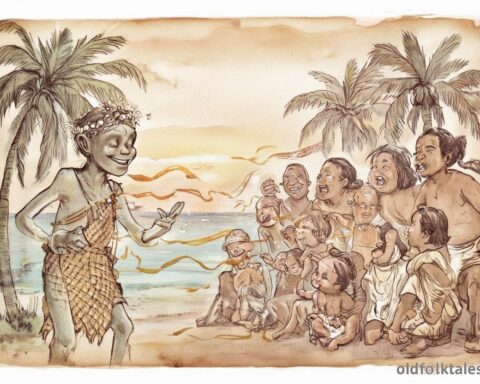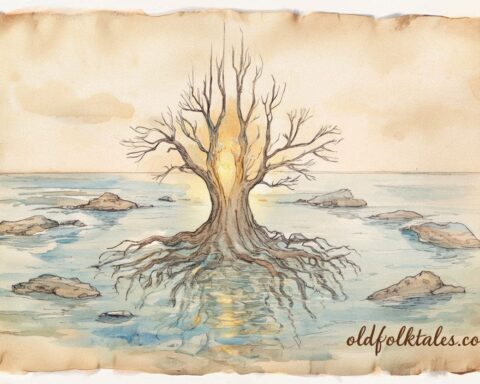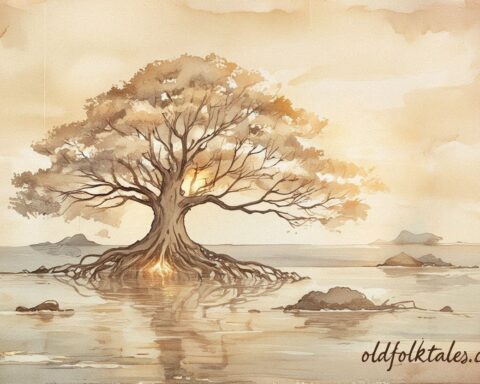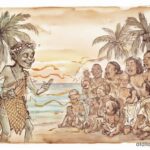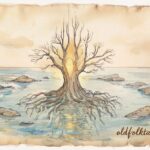After Baiame had shaped the mountains and the rivers, the plains and the forests, he looked upon the land and saw that it was alive but not yet wise. The trees stretched toward the sun, the birds called to one another in the wind, and the waters whispered over the stones. Yet no one understood the meaning of these sounds or the purpose of their rhythms. The world had breath but not memory. It had beauty but not direction.
Baiame, the Sky Father, descended once more from his high dwelling. His steps fell softly upon the red earth. The air shimmered where he walked, for the land recognized the touch of its maker. The people, who had only recently come into being, gathered in wonder at his presence. Their hearts knew him before their eyes did.
He spoke with a voice that rolled like distant thunder and yet was gentle as rain. “Children of my breath,” he said, “I have given you a world filled with every good thing. It is strong and beautiful, but it will remain so only if you walk in balance with it. You must learn how to live, not as rulers of the land, but as its kin.”
Discover how courage and cleverness shaped the storytelling traditions of Micronesia
He gathered the people beneath a great gum tree beside a river. There he began to teach them the sacred ways. He showed them how to make fire, not for destruction but for renewal. He taught them to burn the dry grass so that new shoots would grow, feeding the wallabies and emus. He taught them to hunt with respect, to thank the spirit of every creature whose life was taken for food, and to waste nothing of its body.
“Take only what is needed,” Baiame said. “Give thanks before you take, and share what you have with those who have less. The land will know your gratitude, and it will feed you again.”
He also taught them the arts of gathering. The women learned to find honey in the hollow of trees, roots beneath the earth, and berries hidden among the leaves. The men learned the tracks of the animals and the ways of the winds. He taught both men and women to sing the stories of their country so that the land would always hear its own name and remember its life.
When the people had learned these things, Baiame gathered the elders together. To them he gave knowledge of the sacred ceremonies. He showed them how to paint symbols upon their bodies, each line carrying meaning, each color carrying a story. He told them the dances that mirrored the movements of creation. Through ceremony, he said, the people would renew the bond between themselves and the land.
He gave them law, not written upon stone but spoken into their hearts. These were the laws of right living, respect for elders, care for the young, truth in speech, fairness in action, and harmony in community. Baiame’s words were not commands of fear but of wisdom, spoken with the tenderness of a parent teaching a child.
Time passed, and the people grew wise. They learned that when they followed Baiame’s teachings, the rains came in season, the animals returned, and the land remained full of song. But when they forgot his words and quarreled among themselves, the earth grew silent. The rivers thinned, the game disappeared, and the wind carried no music.
Seeing this, Baiame came to them once again. “You are my children,” he said. “I have given you freedom and the gift of choice. The laws I gave you are not chains. They are the rhythm by which the world stays alive. To live without law is to sing without sound. Remember what I taught you, and the earth will answer your song.”
With those words he rose to the sky once more. His light remained among the stars, a reminder that he still watched and listened. When the people looked upward at night, they saw his campfire burning and felt comforted, knowing that their father was near.
From that time on, the people held fast to his teachings. Each generation told the story of Baiame and his coming to Earth, of the wisdom he gave, and of the harmony he demanded. The young learned to walk softly, to listen for the pulse of the land, and to keep its balance through song and law.
The story of Baiame and Man is told to remind all who hear it that knowledge is not only a gift but a responsibility. To learn is to serve. To live well is to honor creation in every breath.
Moral Lesson
The story teaches that wisdom must be lived, not merely learned. Harmony between people and the land comes through gratitude, obedience, and respect for sacred law.
Knowledge Check
1. Why did Baiame return to the earth?
He returned to teach the first people how to live in harmony with the land and one another.
2. What lessons did Baiame give about hunting and gathering?
He taught respect for animals, to take only what is needed, and to share food within the community.
3. What was the purpose of the ceremonies Baiame taught?
They renewed the bond between humans, the land, and the spirit world.
4. How did Baiame’s laws differ from ordinary rules?
They were not laws of punishment but of harmony and wisdom, guiding right living and gratitude.
5. What happened when people forgot Baiame’s teachings?
The land grew barren, the rivers dried, and the songs of creation fell silent.
6. What lasting reminder did Baiame leave for the people?
His light in the stars, symbolizing his constant watch over creation and humankind.
Source
Adapted from “Baiame and Man” in Aboriginal Myths: Tales of the Dreamtime by A. W. Reed (1978), Terrey Hills, N.S.W.: Reed.
Cultural Origin
Australian Aboriginal (Dreamtime, Kamilaroi and Wonnarua regions)

